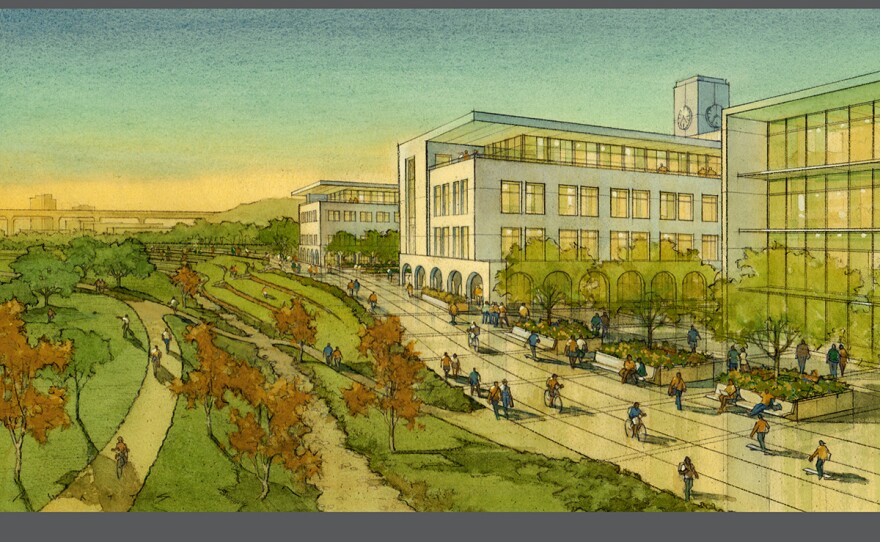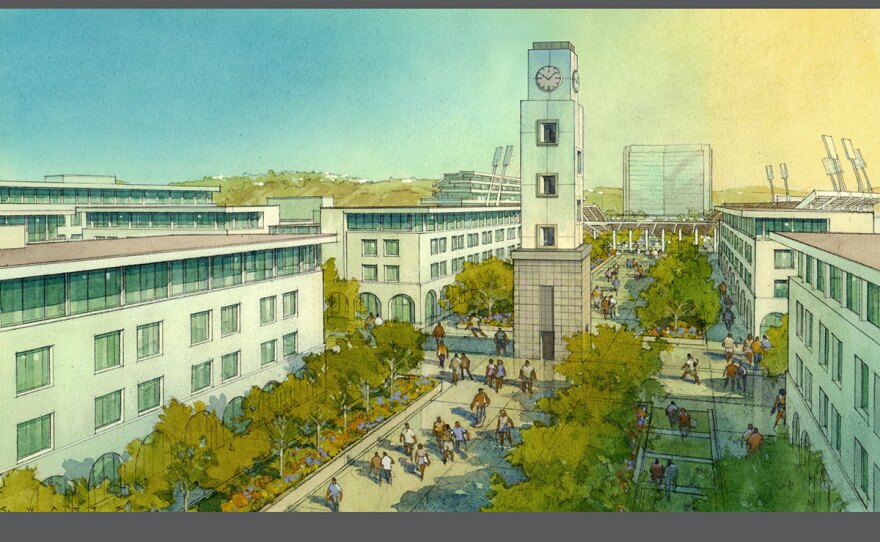San Diego State University Wednesday unveiled a $3 billion plan to expand the campus into Mission Valley and redevelop the SDCCU Stadium (once Qualcomm Stadium) property over the next 15 years.
Supporters have dubbed the proposed development "SDSU West."
The project encompasses 1.6 million square feet of classroom and research buildings, a river park and open space. It would include 4,500 housing units, retail shops, a pair of hotels and a multi-use, 35,000-seat stadium for college football and other sports.
SDSU Interim President Sally Roush and JMI Realty CEO John Kratzer said the project would be mostly funded by public-private partnerships, and wouldn't rely on taxpayer financing. The main exception would be the stadium, which would be funded by bonds that are paid back by future revenues.
"When we look to the future needs of SDSU, Mission Valley represents a once-in-a-lifetime opportunity to acquire a proximate property where we can grow," Roush said.
RELATED: SDSU Alumni Launch Effort To Create West Campus On Stadium Site

The land is three trolley stops from the built-out main campus.
"When SDSU has the opportunity to grow, the region is better served, both in the development of a diverse, highly educated workforce suited to meet San Diego's growing needs, and in the opportunities provided to all San Diegans by way of inclusive economic stimulus," Roush said.
Kratzer said the design will bring a college campus feel to the property.
"It speaks to the scale of the buildings, it speaks to how open spaces are used, it speaks to paseos and how students and pedestrians use the place," Kratzer said. "It speaks to the fact that automobile traffic is 'outboarded' and out of the way. This is not a commercial development plan — this is a campus plan."
He promised a transparent development process that would include a full environmental review.
SDSU officials have for years eyed the city-owned Mission Valley site for expansion, and the property became available when the Chargers left for Los Angeles.
A group of influential SDSU alumni and supporters are collecting signatures for an initiative that would grant the school rights to the land.
A statement sent by Friends of SDSU to City News Service says San Diegans "have shown overwhelming support for SDSU West since we kicked off signature gathering in October. We're right on track to achieve the goal of around 71,000 valid signatures and submit them before the end of December. This milestone will take us one step closer to making SDSU West a reality for our city and San Diego State University."
If enough valid signatures are gathered, the initiative would likely go before voters on the November 2018 general election ballot. It would probably complete with another development plan, called SoccerCity, which has already qualified for the ballot.
RELATED: San Diego City Council Votes To Put SoccerCity On 2018 Ballot

SDSU officials said they need to stay out of the political process for legal reasons but have been under pressure to release details of what San Diegans could expect to go onto the site. Roush acknowledged the "very valid observation" that SDSU officials haven't "clearly articulated" their vision and needs until now.
Gordon Carrier, of the design firm Carrier Johnson + Culture, said the land would be divided into an upper plain for the campus buildings and stadium, and a lower area for the river park. The river flow would be redirected into a more natural flow, and tributaries would be brought within the campus.
He said most of the buildings would be kept within three to six stories in height, and parking would be accommodated by around 5,000 below-grade spaces.
The project also includes a 250-room hotel and conference center, which could also make use of the stadium, and a second 150-room hotel, according to Carrier. He said the housing would be for faculty and staff, and upper division and graduate students, and would include both market-rate and affordable units.
On Thursday, Aztecs athletics officials are scheduled to unveil more details of the stadium portion of the plan. Roush, athletic director John David Wicker, football coach Rocky Long, and Scott Radecic, the founder and senior principal of the Populous stadium design firm, are scheduled to participate.
According to Kratzer, the stadium would be part of the first development phase and take two years to build.






